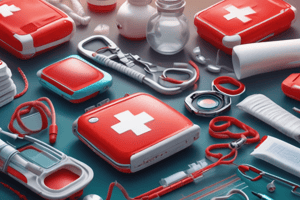Podcast
Questions and Answers
What is the primary goal when treating shock?
What is the primary goal when treating shock?
- To calm the casualty down
- To prevent the condition from getting worse (correct)
- To relieve pain
- To give the casualty food and water
What should you do if you have a nosebleed?
What should you do if you have a nosebleed?
- Take a pain reliever
- Apply an ice pack to your nose
- Sit upright and lean forward (correct)
- Lie down and elevate your feet
Why should you not give the casualty anything to eat or drink when treating shock?
Why should you not give the casualty anything to eat or drink when treating shock?
- To prevent the casualty from getting nauseous
- To prevent re-bleeding
- To allow the casualty to rest
- To prevent the risk of choking (correct)
What should you do after stopping a nosebleed?
What should you do after stopping a nosebleed?
What is the purpose of pinching your nose when treating a nosebleed?
What is the purpose of pinching your nose when treating a nosebleed?
Why should you keep your head higher than the level of your heart after a nosebleed?
Why should you keep your head higher than the level of your heart after a nosebleed?
What can you apply to the inside of your nose to help prevent re-bleeding?
What can you apply to the inside of your nose to help prevent re-bleeding?
What should you do if the bleeding continues after 10 to 15 minutes of pinching your nose?
What should you do if the bleeding continues after 10 to 15 minutes of pinching your nose?
Why is it essential to treat the cause of shock if possible?
Why is it essential to treat the cause of shock if possible?
What should you do if you experience re-bleeding after stopping a nosebleed?
What should you do if you experience re-bleeding after stopping a nosebleed?
Flashcards are hidden until you start studying
Study Notes
Bleeding
- Bleeding, also known as hemorrhage, is the loss of blood from the body, which can occur internally or externally
- Blood loss can occur in almost any area of the body
- Internal bleeding occurs when blood leaks out through a damaged blood vessel or organ
- External bleeding happens when blood exits through a break in the skin
Stopping the Bleed
- Stop the flow of blood
- Wear gloves
- Cover the wound
- Apply pressure
- If a body part has been amputated, put it on ice
Types of Bleeding
- Arterial bleeding:
- Blood spurts from the wound
- Bright, red, oxygen-rich blood
- Most difficult to control due to high pressure
- Venous bleeding:
- Blood flows as a steady stream
- Dark, oxygen-poor blood
- Easier to control
- Capillary bleeding:
- Blood oozes from a capillary and is dark red in color
- Often clots spontaneously
Evaluating a Casualty
- Consider placing a pressure bandage or hemostatic dressing on the wound site or using a tourniquet
- Be aware of the risk of infectious disease from contact with blood or body fluids (HBV and HIV)
Bleeding Control
- Direct Pressure:
- Apply steady, firm pressure
- Use a clean cloth or bandage
- Avoid contact
- Elevate the extremity if no fractures (lie down)
- Apply additional dressings and pressure if bleeding continues
- If bleeding does not stop, apply pressure points and additional dressings
Internal Bleeding
- Signs:
- Discolored, tender, swollen, or hard tissue
- Increased respiratory and pulse rates
- Pale, cool skin
- Nausea and vomiting
- Thirst
- Changes in level of responsiveness
- Can be from severely injured extremities with significant blood loss
Shock
- Causes:
- Fluid loss (bleeding, burns, diarrhea, or vomiting)
- Cardiac problems (heart attack, electrocution)
- Anaphylaxis (severe allergic reaction)
- Signs and symptoms:
- Pale, cold, clammy skin
- Weak, dizzy, lightheaded
- Nausea or vomiting
- Thirsty
- Yawning
- Anxiety or irrational behavior
- Rapid, weak pulse
- Rapid, shallow breathing
- Dropping level of consciousness
First Aid for Shock
- Symptoms:
- Anxiety, confusion, agitation, restlessness, dizziness, cool, clammy, sweating, pale, rapid and shallow breathing, thirst, nausea, vomiting, not responsive
- Check for normal breathing and severe bleeding, treat for these
- Call 112/153
- Put victim on back, raise legs
- Loosen tight clothing
- Turn victim's head if vomiting occurs
- Keep victim warm with coat or blanket
- Give no food or drink, alcohol or tobacco
- Offer reassurance and comfort
- If unresponsive, put in recovery position
Nosebleed Care
- Sit upright and lean forward to reduce blood pressure in the veins of the nose
- Gently blow your nose to clear blood clots
- Spray both sides of your nose with a nasal decongestant containing oxymetazoline (Afrin)
- Pinch your nose using your thumb and index finger to pinch your nostrils shut
- Breathe through your mouth
- Continue pinching for 10 to 15 minutes
- Avoid peeking at your nose
- If bleeding continues, repeat holding pressure for another 10 to 15 minutes
- Seek emergency care if bleeding continues
Studying That Suits You
Use AI to generate personalized quizzes and flashcards to suit your learning preferences.




